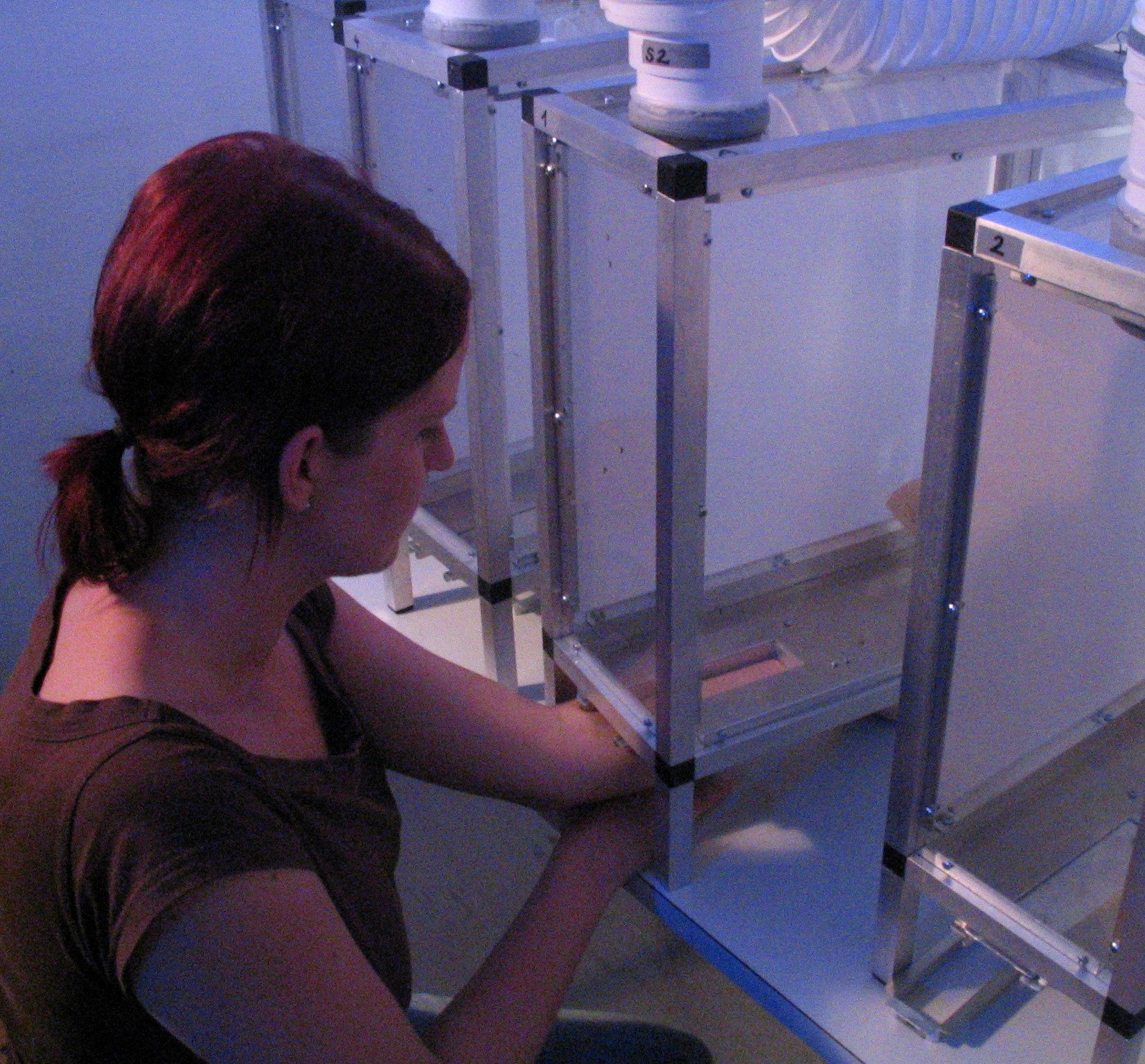It's dark, warm, and humid, and it’s buzzing everywhere. It is this unpleasant sound that drives you crazy during warm summer nights. It’s mosquitoes, thousands of them! The nightmare of many people.
No, I did not get lost in a swamp during the mosquito hatching season. I’m in a mosquito breeding room in the laboratory of Biogents in Regensburg.
We test anti-mosquito products of diverse brands in our contract R&D laboratory. This includes for example, textiles that are either repelling, or bite-proof. However, by far the most frequent tests we perform are of mosquito repellents. Therefore, I am the right person to give you advice on which repellents work to scare off mosquitoes.

This image shows how we test mosquito repellents. Each of these cages contains 30 female mosquitoes. The inner side of the arm is treated and exposed to the mosquitoes at the bottom of the test cage.
What are mosquito repellents and which ones should I use?
Mosquito repellents contain substances that keep mosquitoes away from you. They also work against ticks, but the protection time is usually shorter. These products are available from countless manufacturers in the form of sprays, lotions and creams. They can, however, differ considerably in their duration of action. Some active substances are suitable for children, and others should be used only by adults.
Which active ingredients should I look for in a repellent?
The best-known active substances with proven effect are DEET, Icaridin, IR3535 and PMD. In our laboratory we can demonstrate the effect of these substances quite impressively. When a test person treats an arm with one of these repellents and holds it in a cage full of hungry female mosquitoes, this is what happens: at most a few mosquitoes might land briefly, but no mosquito will bite! We then repeat this procedure every 30 minutes. With a very good repellent, the person still doesn’t get bitten after 6 or even 8 hours!
What are the advantages and disadvantages of the different active ingredients?
- DEET is the active ingredient that has been in use for the longest time. It was patented by the US military in 1946 and was then approved for general use. This substance is purely synthetic. Products containing DEET are among the best-performing repellents in various tests, with an average effective time range of 4 - 8 hours, depending on the test scenario and the amount of active ingredient. Unfortunately, DEET is not a miracle drug, as it has some disadvantages compared to other active ingredients. In high concentrations, DEET can attack certain plastics. It can also cause mucous membrane irritation. For adults, it is the agent of choice when used as directed, especially in hot and humid areas such as the tropics.
- Icaridin (a.k.a Picaridin or Bayrepel) is very similar to DEET in its mode and duration of action. In some tests it performed slightly worse than DEET. It is absorbed by the skin only in small amounts, it cannot attack plastics and is therefore less aggressive than DEET. Icaridin can however still cause irritation on contact with the eyes and mucous membranes and is still not the ideal substance to apply on infants and young children.
For pregnant women, icaridin is the substance of choice, especially in the tropics. In a lower concentration (10%), it can also be used to protect children.
- IR3535 (a.k.a EBAAP) is almost odorless, rapidly biodegradable and is particularly suitable for pregnant women, infants and nursing mothers. However, as it has the shortest protection time of only 1 - 2 hours at high temperatures and high humidity, it is not recommended for use in the tropics. Like Icaridin, IR3535 is suitable for children at a concentration of 10%.
- PMD (a.k.a Citriodiol) was originally discovered in the oil of lemon eucalyptus. It is the only known "natural" active ingredient that can achieve the protection times of the previously mentioned synthetic substances. PMD is usually produced from the chemical conversion of certain essential oils. Products with PMD often have a citrus-like scent.
-
Essential oils as active ingredients in insect repellents are only effective for a very short time, at best. Many essential oils have also been shown to cause allergic reactions. How well do essential oil mosquito repellents work? Check out our videos where you can see me testing tea tree oil, citronella oil, and lavender oil.
Why are mosquitoes scared off by mosquito repellents?
Once applied, the agents are partially absorbed through the skin into the body, where they are broken down and excreted. However, a large portion "vaporizes" off gradually. It is not really these vapors that deter mosquitoes. Mosquitoes are deterred primarily after direct contact with the treated skin. This explains why it is still possible that mosquitoes land on you (without biting!), although you have applied an effective repellent.
The duration of action of the repelling substances can vary greatly from person to person. The main difference in the attractiveness of people to mosquitoes is the composition and amount of certain fatty acids on the skin. The duration of action also depends on the physical properties of the skin. When a product is quickly evaporated or strongly absorbed from the skin, the duration of action is shorter.
Follow these rules when applying mosquito spray:
- Always apply mosquito repellent without gaps. Untreated areas will be found and exploited by mosquitoes, as you can see in this video.
- Can I use mosquito repellent and sunscreen at the same time? If possible, you should avoid it. But if you must, apply sunscreen first and the mosquito repellent after about 20 min.
- Consider the protection time: Products on the market often contain the same active ingredient, but in different concentrations (often indicated with g active ingredient/100 g product). Thus, products with a lower concentration have a shorter protection time. However, the principle that "a lot helps a lot" is also not helpful, since there is an upper limit to effectiveness. If a product protects for five hours when applied once, multiple applications in close succession will still not increase the protection time. You should simply repeat the application after a maximum of five hours.
- Keep in mind that the manufacturer's specifications often represent the maximum protection time of a product. For a repellent with a maximum protection time of 5 hours, you might consider to re-apply after four hours.
- Choose the right active ingredient for your situation. For example, use DEET or Icaridin when you will be out for a long time in a hot and humid environment. If you want to spend a couple of peaceful hours in your garden, a product with PMD or IR3535 is often perfectly sufficient. (To make life in your garden enjoyable without the need of a repellent, consider buying an efficient mosquito trap!)
What about gadgets such as anti-mosquito wristbands, patches and similar? Do they work?
NO - These products don’t work at all to scare off mosquitoes. In the very best case, they look good. Those supposedly anti-mosquito patches that some parents stick on their toddlers‘ clothes are even dangerous, as they can be swallowed by the little ones!
We tested these gadgets in our mosquito lab and the results are very clear. Click on the links to watch the test videos!







